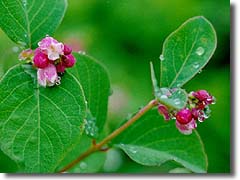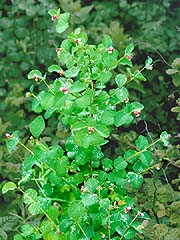Caprifoliaceae (Honeysuckle Family)
Caprifoliaceae are perennial and mostly woody plants that include vines, shrubs, and small trees. The leaves are opposite and usually linear, and sometimes join together to form a disc around the stem (as in the honeysuckles.) The 4 or 5 lobed calyx is usually small, and the 4 or 5 lobed corolla often forms a substantial tube. The lobes may be equal, or formed into two lips with 4 lobes and the upper and 1 large lobe for the lower. The stamens attach to the tube, aternating with the lobes, with the fruiting portion of the pistil below where the calyx and corolla lobes originate. The fruit, usually a fleshy berry, has 2 to 5 seed forming divisions.
The Honeysuckle family is best known domestically in our area from the climbing garden honeysuckle, a close relative of our local Lonicera hispidula vacillans (Hairy Honeysuckle). Many of the wild native species will do well in the garden also, if given the proper conditions they need. The trees (Red Elderberry and Blue Elderberry) can get quite large, and the honeysuckles and snowberries spread aggressively, so they will need room and tending to.

